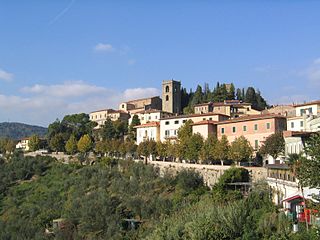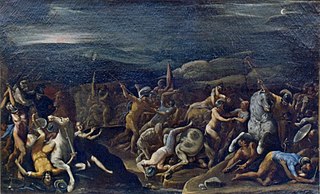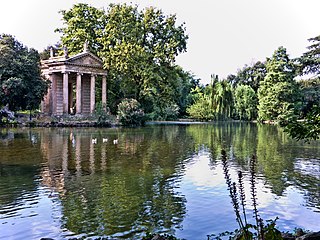
Gaspare Maria Paoletti (December 6, 1727 - February 19, 1813) [1] was a Neoclassical sculptor and architect, active mainly in his native Florence, region of Tuscany, Italy.

Gaspare Maria Paoletti (December 6, 1727 - February 19, 1813) [1] was a Neoclassical sculptor and architect, active mainly in his native Florence, region of Tuscany, Italy.
Paoletti mainly worked for the Tuscan Grand-Dukes of the Hapsburg-Lorraine, and its successors. He became a professor at the Accademia di Belle Arti di Firenze. Among his works are the Palazzina della Meridiana (1775), the White Hall (1776), and the Museum of La Specola, all attached to the Palazzo Pitti. He helped redecorate the Sala della Niobe in the Uffizi Gallery. [2] He worked extensively at the Villa di Poggio Imperiale (1776-1783), and a number of structures at Montecatini Terme (1780). For the latter, he designed the Terme Leopoldine, Bagno del Tettuccio, the Palazzina Reale, and the Locanda Maggiore.
Among his pupils were Giuseppe Manetti, Giuseppe Cacialli, Cosimo Rossi Melocchi, and Pasquale Poccianti.

Alcamo is the fourth-largest town in the province of Trapani in Sicily, with a population of 44.925 inhabitants. It is on the borderline with the Metropolitan City of Palermo at a distance of about 50 kilometres from Palermo and Trapani.

Ca' Rezzonico is a palazzo on the Grand Canal in the Dorsoduro sestiere of Venice, Italy. It is a particularly notable example of the 18th century Venetian baroque and rococo architecture and interior decoration, and displays paintings by the leading Venetian painters of the period, including Francesco Guardi and Giambattista Tiepolo. It is a public museum dedicated to 18th-century Venice and one of the 11 venues managed by the Fondazione Musei Civici di Venezia.

Montecatini Terme is an Italian municipality (comune) of c. 20,000 inhabitants in the province of Pistoia, Tuscany, central Italy. It is the most important center in Valdinievole. The town is located at the eastern end of Piana di Lucca and has a strong vocation for tourism, as well as industrial and commercial industries related to the spa, which in turn has increased the interest for hotel accommodation in the region.
Villa del Poggio Imperiale is a predominantly neoclassical former grand ducal villa in Arcetri, just to the south of Florence in Tuscany, central Italy. Beginning as a villa of the Baroncelli of Florence, it was seized by the Medici, became the home of a homicidal and unfaithful husband, and a lavish retreat for a Grand Duchess with imperial pretensions. Later given to Napoleon's sister, it was reclaimed by the hereditary rulers of Tuscany before being finally converted to a prestigious girls' school. During its long history, it has often been at the centre of Italy's turbulent history, and has been rebuilt and redesigned many times.

The Palazzo Buonaccorsi is an 18th-century aristocratic palace, now the civic museum of the town, located on Via Don Minzoni 24 in the historic center of Macerata, region of Marche, Italy.

Gaspare Celio was an Italian painter of the late-Mannerist and early-Baroque period, active mainly in his native city of Rome.
Ferdinando Orlandi, also referred to as Orland and Orlando. Little is known of his early life and his year of birth is also cited as 1777. He was an Italian musician and teacher of singing who composed cantatas and sacred music, but was particularly known for his operas, not all of which have survived. He was born and died in Parma.

Baldassarre De Caro was an Italian painter of still lifes, mainly of hunted game, but also of flowers. The mood of his paintings is often morbid.

Giuseppe Velasquez, Velasques or Velasco was an Italian painter, active in a Neoclassic style.
Corrado Fortuna is an Italian actor and director.
Gasparo Antonio Turbini was an Italian architect and Jesuit priest, mainly active in a Neoclassical-style in the Province of Brescia, Italy.
Giuseppe Servolini, also known as Sorbolini (1748–1834) was an Italian painter active mainly in Florence.
Vincenzo Monaco was an Italian architect who collaborated with Amedeo Luccichenti from 1933 to 1963. During this period, Monaco designed more than 450 projects, of which approximately 100 were built. His work can be seen in buildings in Rome, Pisa, Naples, and Taranto, as well as in Dalmatia, Iran, France, and Tunisia.

The Chinese Palace, also known as Real Casina alla Cinese, is a former royal residence of the House of Bourbon-Two Sicilies designed in the style of Chinoiserie. It is located in Palermo, inside the park of La Favorita. The Ethnographic Museum of Sicily, named after Giuseppe Pitrè, is located in one of the Palace's guesthouse.

Giovanni Antonio Lecchi or Giannantonio Lecchi was an Italian jesuit and mathematician.

Pinciano is the 3rd quartiere of Rome (Italy), identified by the initials Q. III. The name derives from the Pincian Hill. It belongs to the Municipio II.

Andrea Carrera or Carreca was an Italian Baroque painter mainly active in Sicily. He was born in Trapani and died in Palermo.

The Palazzina Reale delle Cascine is a small Neoclassical palace sited on the Piazzale delle Cascine within the public park located along the north bank of the Arno river just north of central Florence, Italy. Built in the mid-18th century by the Lorraine Duke of Florence, in 2020 now houses part of the offices of the faculty of agricultural and forestry sciences of the University of Florence.

Alessandro Mazzucotelli was an Italian craftsman, particularly known as a master ironworker and decorator. A specialist in wrought iron, Mazzucotelli linked his fame to the decorations of the works of the major exponents of Art Nouveau in Italy and abroad.